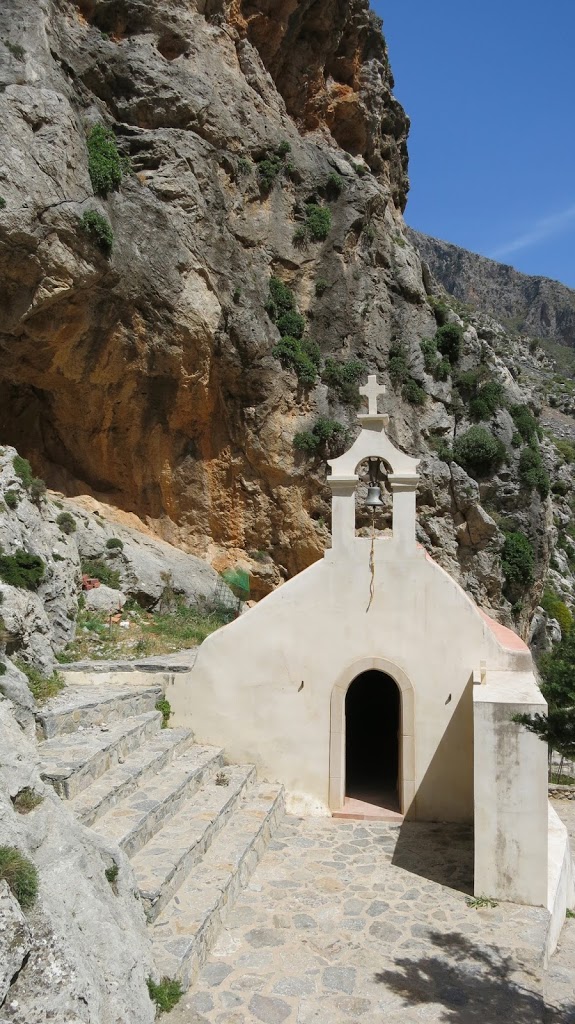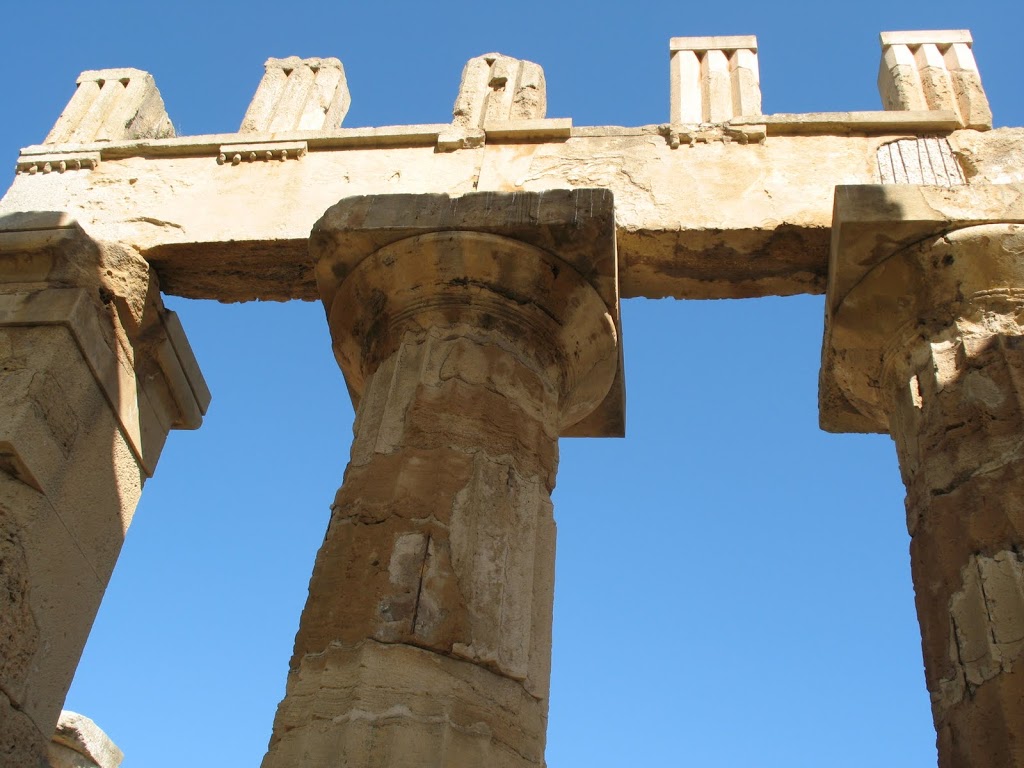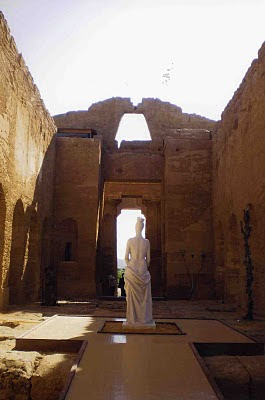
by admin | Jul 29, 2013 | Architecture, Byzantine Art, Church of Zoohodos Pigi, Crete, Medieval Art, The Greek World
 |
| The Church of St. Nicholas in Kourtaliotis Gorge, Crete |
 |
| Piles of stones beside St. Nicholas Church |
I cherish my trips with Backroads Travel Co. To me the backroads of Crete are full of surprises, in addition to olive orchards, oleanders and orange groves. On our 3rd day we road from the north to south part of the island. On the way to the beach at Plakias, we bicycled through the Kourtaliotis Gorge. The scenery was breathtaking. A tiny church, St. Nicholas was nestled behind the oleander and the rocks. It seemed to be a place where only a handful of monks prayed a long time ago. Behind it were small piled-up shrines of stone, which resemble votive offerings beside the church.
Crete’s small country churches surprised me, but even smaller churches, or replicas of churches dot the sides of the country roads. These small shrines are all over the place.
 |
| A typical memorial erected among the orange groves of Crete |
They’re memorials to loved ones who’ve died and we saw them frequently. One of the hotshot men on our trip, Dennis, reprimanded me for taking photos of graves in churchyards. He told me, “It is bad luck.” (His mother’s family is from Crete.)
The day after we went to the Kourtaliotas Gorge, I experienced bigger surprises — a pair of surprises. Cindy (she lives in Shanghai and was also on the lookout for great photos) & I came upon an abandoned church, seemingly in the middle of nowhere. We both took pictures. Cindy biked on, but I decided to check out the inside.
 |
| A 14th century church between the villages of Koufos and Alikianos |
Through the opening of a locked door, I could see that in the center of the church was a fresco of Mary surrounded by two saints. It was too narrow to photograph, but the image was clear but had two big vertical cracks. There were more frescoes to the sides and above, but I really couldn’t see them.
On the outside of the church, a fresco of Mary adorns the pointed arch over a side door. It was badly damaged, but I took a picture (below). It also had painted trim directly under the arch in a beautiful red and blue pattern, and a Greek cross below that.
 |
A badly damaged fresco of Mary over the door dates
to the 14th century |
Paintings on the outside of a buildings can’t withstand time and weather.
The sign on the road pointed to Church of the Zoohodos Pigi (in Greek and in English, but what could that possibly mean?) (Later when I was home and looked it up on the Internet, I found a few churches of the same name in Greece.)
This church lies between Alikianos and Koufos. It was built in the early 14th century following an earthquake of 1303, but over the foundations of a 10th century church. (Earthquakes have always been a problem on this island, and in much of the Mediterranean.)
 |
| Zoohodos Pigi means “life giving source.” |
El Greco, Greece’s greatest artist in modern times, was from this part of Crete. No one knows exactly where El Greco was born, but his family was from Chania and this church is about 10-20 miles away.
We had already passed a town called Alikianos where there was large new blue and terra cotta colored Greek Orthodox church. It’s easy to understand why a church in the middle of nowhere was abandoned.
I hope that the Church of Zoohodos Pigi will be restored. Apparently it was quite an important church at one time. Zoohodos Pigi means “life-giving source.”
 |
| There’s a new Greek Orthodox church in the village of Alikianos |
|
|
|
Just a few miles down the road, I had caught up with Cindy. We had to go up hills too steep for my endurance, and then we turned a corner and stopped. Here came the the biggest surprise of all:
It was lunch time and someone had just dumped a big truck of excess oranges in a goat pen and the goats were chomping away, peels and all. They were chomping like crazy, as if in a contests to finish first. We took many pictures.
How funny to realize that these delicious goat cheeses we’ve been eating in Crete come from animals who feed on oranges, the delicious oranges of Crete!
 |
| The Goats’ lunch — so good! |
I discovered both Greek cheeses and orange cake, also called orange pie, on this trip. My grocery store oranges aren’t quite like the oranges I had been eating, and I haven’t found Graviera cheese in any of my local markets. There’s nothing like feeling close to history, the land, the animals and the sea than in a Backroads biking trip.

by admin | Feb 25, 2011 | Architecture, Art and the Environment, Sicily, The Greek World
 In Selinunte, Sicily, the remains of several Greek temples from the 6th- 5th century BC reveal much about temple construction, although they fell to Carthaginian invasions and earthquakes not long
In Selinunte, Sicily, the remains of several Greek temples from the 6th- 5th century BC reveal much about temple construction, although they fell to Carthaginian invasions and earthquakes not longafter their building. Temple E has most of its outer colonnade, the peristyle, restored.Classical harmony is apparent in the rhythm of fluted columns, continuing up into the triglyphs raised to the sky.
Architect Mark Schara, with his good eye for detail, took almost all of these photos.
.
 But many of the capitals have fallen. On the ground level, we can appreciate their large scale.
But many of the capitals have fallen. On the ground level, we can appreciate their large scale.

Temple F was badly damaged. Much of the white stucco facing for the fluted limestone column on right is still visible.
Tem
ple G, below, was the largest of the 7 temples of Selinunte, the ancient city of Silenus.
 This temple had columns about 54 feet tall. Here, we see the columns were made of individual segments called drums, each of which are 12 feet high
This temple had columns about 54 feet tall. Here, we see the columns were made of individual segments called drums, each of which are 12 feet high.

The overturned capitals, echinus on top of the abacus, has an 11′ diameter. Here, the abacus and echinus were carved in one piece, unlike above at Temple E.
At the time of destruction, not all of the capitals had been fluted. Thus we
know that the temple was never completed
Nearby in Agrigento, the ancient city called Akragas, had a series of ten te
mples in the Valley of the Temples.
The Temple of Concord is one of the best preserved Doric temples.
It had been converted into a church in the early Christian period.
In the 8th -3rd centuries BCE, Sicily was a battleground between Greeks who settled 3/4 of the island and Carthaginians who settled the western portion; then it became the target of Roman conquest.
 Though only a small portion of the peristyle remains, the
Though only a small portion of the peristyle remains, the
Temple of Hera was in better condition than most of these temples
which fell victim to Carthaginian destruction, then earthquakes.
But an even taller temple to Olympian Zeus would have been the largest of
Doric Greek temples, the height of a 10-story building; it was incomplete when the disaster struck.
 Construction began in 480 BCE and was still in progress when it was decimated in 407 BCE. The Telemon or Atlas figures whose bent arms support the architravemay in fact represent Carthaginian prisoners who had been made to build the temple.
Construction began in 480 BCE and was still in progress when it was decimated in 407 BCE. The Telemon or Atlas figures whose bent arms support the architravemay in fact represent Carthaginian prisoners who had been made to build the temple.  But even these giants, who appear to have held up the building, have fallen,
But even these giants, who appear to have held up the building, have fallen,
struck down by the Carthaginians who conquered Akragras.
Only a replica of one of the ruined giants remains on the site. Ancient Akragas may have had 200.000 people in the 5th century BCE.Today we witness the fallen giant as a symbol of human pride grown too large,
Ancient Akragas may have had 200.000 people in the 5th century BCE.Today we witness the fallen giant as a symbol of human pride grown too large,
and, consequently, fallen. by admin | Apr 28, 2010 | Architecture, Sicily, The Greek World

The gigantic Temple of Olympian Zeus, Agrigento, was damaged by earthquakes before completion. This new statue, a flying bronze, echoes the temple’s fallen state. The wing overlaps and seems to touch a huge Doric capital to the right of the middle.

I was recently in Sicily to view mainly the ancient Greek sites. My camera broke and thankfully Kelli Palmer is letting me share her pictures of Agrigento, a city known for the beauty of its golden limestone.
The Temple of Concord in Agrigento is one of the best preserved Greek temples standing today, probably due to the fact that it was used as a church in the Middle Ages. Right now contemporary sculpture is on display there and at the other temples in Agrigento. The combination of antique/modern — though not always successful — is particularly well done at this site because it does not detract from the ancient architecture while displaying the new work effectively. The sculptures seem to be made for this purpose.

A nude comfortably “bronzes”herself on the
porch of a 5th century BC Doric temple. It is
not known to whom the temp le wasdedicated
le wasdedicated.
Bronze hands reach upward, perhaps
expressing aspirations appropriate to
either church or temple. The arches date from the middle ages. The medieval builders cut arches into the walls, changing the ancient temple’s “cella”
into a church’s nave.
The modern marble figure, draped in a fashion reminiscent of the Venus de Milo, is far more sensual than a cult statue to Demeter, Persephone, Aphrodite or even the Christian Mary would have been in a religious building. But it stands harmoniously in this room which had been converted into a church’s nave in the 6th century. The relationship of a church‘s nave to its side aisles is similar to the relationship of an inner temple (the cella) to the outer colonnade.


























Recent Comments